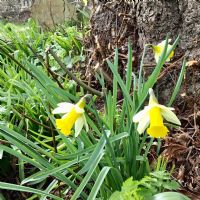

|
|
|
Daffodils (Narcissus Pseudonarcissus) Daffodils (Narcissus Pseudonarcissus) Date added: 02/04/2023 08:20:51 Daffodils pop up when Winter is ending with their bright and cheerful yellow flowers which are symbolic of Spring, rebirth and new beginnings. They are also associated with hope and resilience in the face of disease and have become the emblem of many cancer fundraising societies across the world. They are the National Flower of Wales and are worn on March 1st which is celebrated as St David’s Day. We have daffodils in the cemetery - rather few but some are the true wild ones with their pale yellow sepals and darker trumpets set off by their long, narrow grey -green leaves. As well as lifting our spirits both indoors and outdoors, they have been credited, in the past, with other health benefits in the treatment of colds, chest conditions, joint discomfort and wound healing. When planted in orchards they can increase the number of pollinators just when they are needed and so improve the fruit crop. Deer may be deterred by the leaves which make grazing difficult. All parts of the plant are toxic and can cause a range of alarming symptoms from vomiting , through skin reactions, to death and so there is now no place for them as natural cures or food. Both the cut flowers and the bulbs should be handled with care. However, some research shows that it may be possible to develop a helpful medication for dementia sufferers. Snowdrops, belonging to the same botanical group, have already yielded galantamine which is in use in treating these patients. Finally, words of wisdom from the Prophet Muhammad who praised the flower saying: “Whoever has two loaves of bread, let him sell one and buy a narcissus for while bread nourishes the body, the narcissus feeds the soul.“ © FNRC
Images related to this news article |
Website designed and maintained by Paul Thompson on behalf of the Friends of Newtown Road Cemetery.

